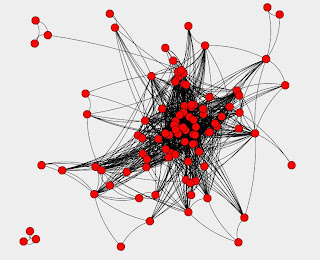

It's my individual project. :)
Research questions:
How does online inequality play out in the online social networking sites MySpace and Facebook?
What types of demographics appeal to MySpace vs. Facebook?
How does Facebook motivate "honors kids," white kids, rich kids, and kids of higher socioeconomic statuses to abandon MySpace and join Facebook?
How does danah boyd's observations about teenagers on these social networking sites translate into the actions of high-school graduates? In other words, what adults join Facebook over MySpace and why?
Sites used:
www.facebook.com
www.myspace.com
Both are global social networking sites that allow users to add friends, send messages, leave comments, upload and tag photos, post events, etc. The main differences between each website is the aesthetic of user profiles (MySpace can be altered in "creative" ways, whereas Facebook cannot) and the ability to post music to one's page (this enables many bands to have MySpace profiles, where Facebook is more likely to represent individuals or organizations).
Literature Review:
http://group-processes-social-change.blogspot.com/2009/09/digital-inequality.html
I used Elyse's post on our class blog to find the main article I used to illustrate the MySpace-Facebook divide.
http://causeglobal.blogspot.com/2009/07/white-flight-online.html
This is the article Elyse's post on our class blog led me to. The article from Cause Global: Social Media For Social Change's blog titled "'White Flight' Online?" summarizes Net researcher danah boyd's observations regarding the idea that "long-held social divisions of race, class, and income are beginning to play out online, particularly among teens now choosing which social network they prefer, MySpace or Facebook" which boyd presented at the Personal Democracy forum in New York last June.
http://www.danah.org/papers/essays/ClassDivisions.html
This is danah boyd's initial article, published in 2007, based on her observations about the class differences between teens switching to Facebook or sticking with MySpace. Boyd cautions that this is not an academic article but is rather her observations in the field; however, boyd had "analyzed over 10,000 MySpace profiles, clocked over 2000 hours surfing and observing what happens on MySpace, and formally interviewed 90 teens in 7 states with a variety of different backgrounds and demographics. But that's only the tip of the iceberg. I ride buses to observe teens; I hang out at fast food joints and malls. I talk to parents, teachers, marketers, politicians, pastors, and technology creators. I read, I observe, I document," according to boyd's description of her methodology. Also, the article published two years later on Cause Global clearly shows that boyd's research had progressed, and she had conducted interviews and gathered more data on the topic.
Data collection:
I used the articles above to flush out my own assumptions about the MySpace-Facebook divide and to present boyd's data to the class. I also observed my own friends on each networking site (610 on Facebook and 339 on MySpace) to make some general assumptions about who joins Facebook after high school and who remains active on MySpace.
Conclusions and connections:
Boyd's data concluded that teens who were wealthier, white, from the suburbs, and were likely to attend college after high school were most likely to move from MySpace to Facebook when Facebook opened its doors to non-college students. However, working-class teens, minorities, and alternative teens ("emo" kids, "wangstas") were more likely to stick with MySpace. Based on personal experience and my own observations using these sites, teens who are in high school or younger are more likely to have and actively contribute to their MySpace than high school grads. Also, adults with professional careers (professors, real estate agents, psychiatrists) seem more likely to join Facebook while working-class adults are active on MySpace. I find that friends of mine who went to or are attending universities are more likely to be on Facebook and to have abandoned MySpace altogether, whereas friends who still live at home with parents, attend community college or do not attend college at all, have children, or are extremely involved in music are more likely to still be active MySpace members (even if they also joined Facebook to keep in touch with other high school friends). I have noticed a significant number of my friends who are members of both sites share different information on each site as well. For example, friends from high school who now have children are more likely to post many photos of their children on MySpace than on Facebook.
Future Research:
I would be interested in coding and analyzing either a random sample or the first 100 of my friends alphabetically on each site to see if there is a significant socioeconomic and academic difference between MySpace and Facebook users. I would also be interested to observe my friends who are members of both networking sites to see which site they more actively participate on, and whether this corresponds with their socioeconomic and academic statuses, along with their number of children. I also got some great suggestions in class about ways to use Quantcast, ways to code different demographics, and other factors to consider when doing further research.









